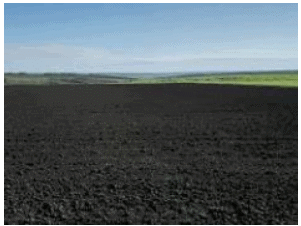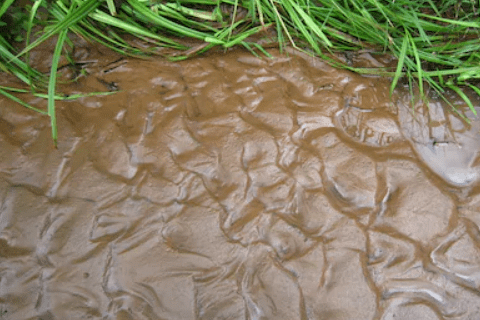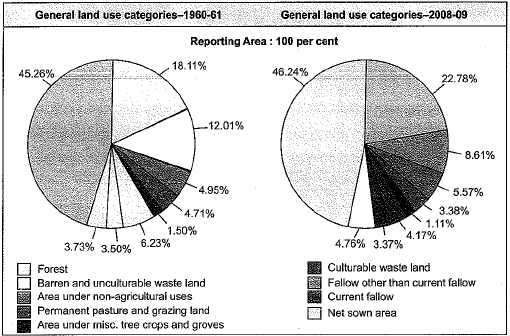NCERT Solutions for Class 10 Geography Chapter 1 - Resources and Development
Q1. Multiple-Choice Questions
(i) Which one of the following is the main cause of land degradation in Punjab?
(a) Intensive cultivation
(b) Deforestation
(c) Over irrigation
(d) Overgrazing
Ans: (c) Over irrigation
In Punjab, Haryana, and western Uttar Pradesh, excessive irrigation is causing land degradation. This happens because too much water is causing waterlogging, which increases the soil’s salinity and alkalinity.
(ii) In which one of the following states is terrace cultivation practised?
(a) Punjab
(b) Plains of Uttar Pradesh
(c) Haryana
(d) Uttarakhand
Ans: (d) Uttarakhand
Step farming or terrace cultivation is practiced in hilly areas to decrease the flow of water down the slopes. Here, Uttarakhand is the only region with hills.
 Terrace Cultivation
Terrace Cultivation
(iii) In which of the following states black soil is predominantly found?
(a) Uttar Pradesh
(b) Rajasthan
(c) Maharashtra
(d) Jharkhand
Ans: (c) Maharashtra
Black soil is found in Maharashtra, Saurashtra, Malwa, Madhya Pradesh and Chhattisgarh and extend in the south east direction along the Godavari and the Krishna valleys.
Q2. Answer the following questions in about 30 words.
(i) Name three states having black soil and the crop which is mainly grown in it.
Ans: The three states are
- Maharashtra
- Madhya Pradesh
- Gujarat
And the crop which is mainly grown on black soil is cotton.
 Black Soil
Black Soil
(ii) What type of soil is found in the river deltas of the eastern coast? Give three main features of this type of soil.
Ans: Alluvial soil is formed in the river deltas of the eastern coast. Its main features are-
- Alluvial soil is rich in potassium and phosphoric acid and lime.
- It has a high water retention capacity.
- It is highly fertile soil.
 Alluvial Soil
Alluvial Soil
(iii) What steps can be taken to control soil erosion in the hilly areas?
Ans: Some steps that can be followed to prevent soil erosion in hilly areas include:
- Contour ploughing
- Terrace farming
- Strips cropping
Q3. Answer the following questions in about 120 words.
(i) Explain the land use pattern in India and why has the land under forest not increased much since 1960-61?
Ans:
(a) The land use pattern in India in 1960-61 and 2008-09 is given in the figure given below:
 Source: Directorate of Economics and Statistics, Ministry of Agriculture, 2008 - 09
Source: Directorate of Economics and Statistics, Ministry of Agriculture, 2008 - 09
(b) From above it is clear that in 2008-09, the main uses are as mentioned below:
- Net sown area - 46.24%
- Forest - 22.78%
- The rest is used for other purposes such as non-agricultural uses, tree crops, groves etc.
(c) The land under forest has shown only marginal increase (0.98%). This is due to increasing population, industrialization and urbanization.
(ii) How have technical and economic development led to more consumption of resources?
Ans: (a) As technology improves with development, more resources are needed for production.
(b) According to Gandhi, the misuse of modern technology is a major cause of resource depletion worldwide.
(c) The advanced technology of colonial powers allowed them to exploit resources and dominate the countries they colonized.
(d) Resources only help in development if there is suitable technology and the right changes in institutions of the country. India went through these stages during colonization.
Example: In Punjab and Haryana, water resources are heavily used to increase irrigation and farming during dry seasons. This has led to a drop in water levels, causing problems for farmers.
|
62 videos|446 docs|87 tests
|
FAQs on NCERT Solutions for Class 10 Geography Chapter 1 - Resources and Development
| 1. What are the different types of resources discussed in the chapter on Resources & Development? |  |
| 2. How can we conserve natural resources as mentioned in the chapter? |  |
| 3. What is the significance of sustainable development in resource management? |  |
| 4. Can you explain the difference between renewable and non-renewable resources? |  |
| 5. What role does population play in resource development according to the chapter? |  |























